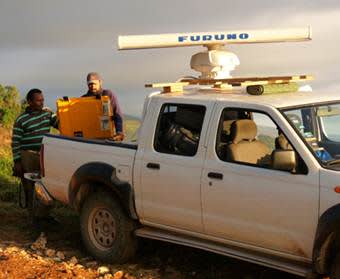Sci-fi Devices Find New Application, Finding Colonies of Mystery “Devil” Bird
OutdoorHub 03.19.12

The sci-fi world of high tech devices such as night vision goggles, thermal imaging readers, and portable radar systems is finding a new and unusual application – helping to save the Black-capped Petrel, an endangered bird so rare and reclusive that conservationists have a hard time even figuring out where its nesting areas are. Its known nesting range on Hispaniola in the Caribbean, its nocturnal habits, and the strange sounds it sometimes makes have conjured devilish associations, and provided it with its local name, “Diablotin,” or Little Devil.
By using cutting-edge technology — portable radar systems and thermal imaging devices — researchers were recently able to produce pictures of 150 individuals in a span of only four hours, in an area where only four or five individuals had previously been identified, and then only by the sound of their calls.
“The novel application of this technology allowed us to discover new breeding sites of these birds recently on Hispaniola. We investigated a site where we had previously heard only a handful of individuals, and were amazed at how many birds were actually there,” said Dr. Jessica Hardesty Norris, Seabird Program Director for American Bird Conservancy, and co-author of the recently produced conservation plan to protect the species.
The research team used portable marine radar to determine the flight paths of birds as they came in from the open ocean. When they picked up an incoming bird, they called a team of look-outs perched in clearings along the mountainous ridge, who were then able to watch the birds as they reached their nesting areas. The lookouts used night vision goggles, which amplify even small amounts of light, and a thermal imaging camera, which can detect the birds even in full dark or in foggy conditions. With this technology they were able to observe the bird’s habits and pinpoint new nesting sites.
“One of the interesting things was how much we learned about behavior. Just after sunset, the breeding adults that have been sitting on the nest all day start to leave, quietly heading out to sea. After about an hour, birds that have been out at sea foraging all day head toward the breeding area, where they greet each other and socialize. They are probably young or inexperienced birds who probably won’t breed this year, but they congregate for a few hours each night, perhaps meeting likely mates or learning a little about how to set up housekeeping,” said Adam Brown, a Senior Biologist with Environmental Protection in the Caribbean. Brown used radar on Marbled Murrelets in Northern California, and hopes the technology can help to find nesting areas in Dominica and other islands where the birds may still persist. In the Dominican Republic, the team included members from Grupo Jaragua, Cornell Laboratory of Ornithology, and a radar specialist from ARD Consulting.
They also plan to evaluate petrel behavior near cell phone towers with radar and/or thermal imaging, and deploy remote listening units to record petrel calls. “About the only thing we’re not using to find and protect these birds are drones, but if someone offered us the use of one, I’m sure we could put it to very good conservation use,” said Hardesty Norris. The fact that the species comes ashore under the cover of darkness, nests in burrows up to three meters deep, and prefers to nest on near-vertical cliffs has made the discovery of Diablotin nesting areas and nests incredibly difficult. However, with these new technologies, we have greatly increased our chances of locating nesting petrels,” says Brown.
International Black-capped petrel team at work in the Dominican Republic, examining radar images. (Ernst Rupp of Grupo Jaragua at Computer)
The Black-capped Petrel, which has an estimated world population of only around 2,000 individuals, was thought extinct until it was rediscovered in 1963. It acquired its nickname, as a result of its nocturnal nature, its unique eerie calls and its tendency to produce a haunting, flutelike sound during nocturnal flights, apparently created by wind passing over its wings.
The Black-capped Petrel is threatened by predation from introduced mammals, deforestation, human encroachment and exploitation. Urbanization and associated increases in artificial lights likely increase risks of collision with trees, wires, and buildings. At sea, offshore energy development and oil spills may pose additional hazards.
The newly discovered nesting sites are located in a national park. Though the park is protected on paper, there is charcoal production and other logging in the immediate vicinity, so the team has a serious concern about the long-term conservation of these nesting sites.
The Diablotin nests in burrows or crevices in cliffs in montane forest at an elevation of 5,000 – 7,500 feet. Nesting birds commute long distances from their breeding sites in the mountains to foraging sites at sea where they feed on fish, invertebrates, and squid.
While Diablotin are known to range up the U.S. East Coast as far as New England, they are confirmed to breed only on Hispaniola in Haiti and the Dominican Republic. Researchers suspect, however, that they may persist on Cuba, Jamaica, and on Dominica, where they have been seen both off the coast and inland. The bird was once common on Guadeloupe, but was extirpated there in the 19th Century; it apparently also existed on Martinique.

